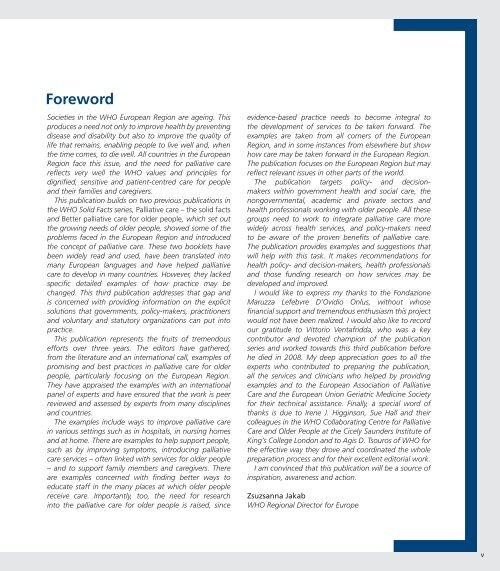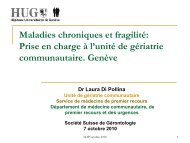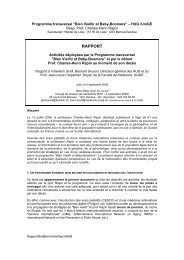Palliative care for older people - World Health Organization ...
Palliative care for older people - World Health Organization ...
Palliative care for older people - World Health Organization ...
Create successful ePaper yourself
Turn your PDF publications into a flip-book with our unique Google optimized e-Paper software.
ForewordSocieties in the WHO European Region are ageing. Thisproduces a need not only to improve health by preventingdisease and disability but also to improve the quality oflife that remains, enabling <strong>people</strong> to live well and, whenthe time comes, to die well. All countries in the EuropeanRegion face this issue, and the need <strong>for</strong> palliative <strong>care</strong>reflects very well the WHO values and principles <strong>for</strong>dignified, sensitive and patient-centred <strong>care</strong> <strong>for</strong> <strong>people</strong>and their families and <strong>care</strong>givers.This publication builds on two previous publications inthe WHO Solid Facts series, <strong>Palliative</strong> <strong>care</strong> – the solid factsand Better palliative <strong>care</strong> <strong>for</strong> <strong>older</strong> <strong>people</strong>, which set outthe growing needs of <strong>older</strong> <strong>people</strong>, showed some of theproblems faced in the European Region and introducedthe concept of palliative <strong>care</strong>. These two booklets havebeen widely read and used, have been translated intomany European languages and have helped palliative<strong>care</strong> to develop in many countries. However, they lackedspecific detailed examples of how practice may bechanged. This third publication addresses that gap andis concerned with providing in<strong>for</strong>mation on the explicitsolutions that governments, policy-makers, practitionersand voluntary and statutory organizations can put intopractice.This publication represents the fruits of tremendousef<strong>for</strong>ts over three years. The editors have gathered,from the literature and an international call, examples ofpromising and best practices in palliative <strong>care</strong> <strong>for</strong> <strong>older</strong><strong>people</strong>, particularly focusing on the European Region.They have appraised the examples with an internationalpanel of experts and have ensured that the work is peerreviewed and assessed by experts from many disciplinesand countries.The examples include ways to improve palliative <strong>care</strong>in various settings such as in hospitals, in nursing homesand at home. There are examples to help support <strong>people</strong>,such as by improving symptoms, introducing palliative<strong>care</strong> services – often linked with services <strong>for</strong> <strong>older</strong> <strong>people</strong>– and to support family members and <strong>care</strong>givers. Thereare examples concerned with finding better ways toeducate staff in the many places at which <strong>older</strong> <strong>people</strong>receive <strong>care</strong>. Importantly, too, the need <strong>for</strong> researchinto the palliative <strong>care</strong> <strong>for</strong> <strong>older</strong> <strong>people</strong> is raised, sinceevidence-based practice needs to become integral tothe development of services to be taken <strong>for</strong>ward. Theexamples are taken from all corners of the EuropeanRegion, and in some instances from elsewhere but showhow <strong>care</strong> may be taken <strong>for</strong>ward in the European Region.The publication focuses on the European Region but mayreflect relevant issues in other parts of the world.The publication targets policy- and decisionmakerswithin government health and social <strong>care</strong>, thenongovernmental, academic and private sectors andhealth professionals working with <strong>older</strong> <strong>people</strong>. All thesegroups need to work to integrate palliative <strong>care</strong> morewidely across health services, and policy-makers needto be aware of the proven benefits of palliative <strong>care</strong>.The publication provides examples and suggestions thatwill help with this task. It makes recommendations <strong>for</strong>health policy- and decision-makers, health professionalsand those funding research on how services may bedeveloped and improved.I would like to express my thanks to the FondazioneMaruzza Lefebvre D’Ovidio Onlus, without whosefinancial support and tremendous enthusiasm this projectwould not have been realized. I would also like to recordour gratitude to Vittorio Ventafridda, who was a keycontributor and devoted champion of the publicationseries and worked towards this third publication be<strong>for</strong>ehe died in 2008. My deep appreciation goes to all theexperts who contributed to preparing the publication,all the services and clinicians who helped by providingexamples and to the European Association of <strong>Palliative</strong>Care and the European Union Geriatric Medicine Society<strong>for</strong> their technical assistance. Finally, a special word ofthanks is due to Irene J. Higginson, Sue Hall and theircolleagues in the WHO Collaborating Centre <strong>for</strong> <strong>Palliative</strong>Care and Older People at the Cicely Saunders Institute ofKing’s College London and to Agis D. Tsouros of WHO <strong>for</strong>the effective way they drove and coordinated the wholepreparation process and <strong>for</strong> their excellent editorial work.I am convinced that this publication will be a source ofinspiration, awareness and action.Zsuzsanna JakabWHO Regional Director <strong>for</strong> Europev5
















